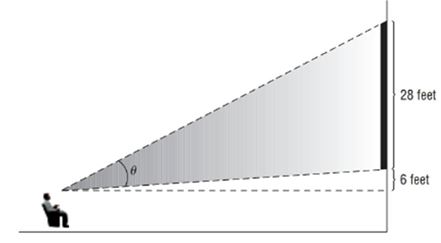
Concept explainers
Movie Theater Screens Suppose that a movie theater has a screen that is 28 feet tall. When you sit down, the bottom of the screen is 6 feet above your eye level. The angle formed by drawing a line from your eye to the bottom of the screen and another line from your eye to the top of the screen is called the viewing angle. In the figure, is the viewing angle. Suppose that you sit feet from the screen. The viewing angle is given by the function .

What is your viewing angle if you sit 10 feet from the screen? 15 feel? 20 feel?
If there are 5 feet between the screen and the first row of seats and there are 3 feet between each row and the row' behind it. which row results in the largest viewing angle?
Using a graphing utility, graph .
What value of results in the largest viewing angle?
Want to see the full answer?
Check out a sample textbook solution
Chapter 7 Solutions
MML PRECALCULUS ENHANCED
Additional Math Textbook Solutions
Elementary Statistics
A First Course in Probability (10th Edition)
A Problem Solving Approach To Mathematics For Elementary School Teachers (13th Edition)
Elementary Statistics: Picturing the World (7th Edition)
College Algebra with Modeling & Visualization (5th Edition)
- i+2j+3k = (1,2,3) and b = -i-k. Calculate the cross product a x b where a Next calculate the area of the parallelogram spanned by a and b.arrow_forwardThe measured receptance data around two resonant picks of a structure are tabulated in the followings. Find the natural frequencies, damping ratios, and mode shapes of the structure. (30 points) (@)×10 m/N α₁₂ (@)×10 m/N w/2z (Hz) 99 0.1176 0.17531 0.1114 -0.1751i 101 -0.0302 0.2456i -0.0365 -0.2453i 103 -0.1216 0.1327i -0.1279-0.1324i 220 0.0353 0.0260i -0.0419+0.0259i 224 0.0210 0.0757i |-0.0273 +0.0756i 228 -0.0443 0.0474i 0.0382 +0.0474iarrow_forward== 1. A separable differential equation can be written in the form hy) = g(a) where h(y) is a function of y only, and g(x) is a function of r only. All of the equations below are separable. Rewrite each of these in the form h(y) = g(x), then find a general solution by integrating both sides. Determine whether the solutions you found are explicit (functions) or implicit (curves but not functions) (a) 1' = — 1/3 (b) y' = = --- Y (c) y = x(1+ y²)arrow_forward
- A circle of radius r centered at the point (0,r) in the plane will intersect the y-axis at the origin and the point A=(0,2r), as pictured below. A line passes through the point A and the point C=(11/2,0) on the x-axis. In this problem, we will investigate the coordinates of the intersection point B between the circle and the line, as 1 → ∞ A=(0,2r) B (0,0) (a) The line through A and C has equation: y= 2 117 x+27 (b) The x-coordinate of the point B is 4472 121,2 +4 40 (c) The y-coordinate of the point B is +27 121 44 (d) The limit as r→ ∞ of the x-coordinate of B is 121 (if your answer is oo, write infinity).arrow_forward1. Show that the vector field F(x, y, z) = (2x sin ye³)ix² cos yj + (3xe³ +5)k satisfies the necessary conditions for a conservative vector field, and find a potential function for F.arrow_forwardi need help pleasearrow_forward
- 6. (i) Sketch the trace of the following curve on R², (t) = (sin(t), 3 sin(t)), tЄ [0, π]. [3 Marks] Total marks 10 (ii) Find the length of this curve. [7 Marks]arrow_forwardhelppparrow_forward7. Let F(x1, x2) (F₁(x1, x2), F2(x1, x2)), where = X2 F1(x1, x2) X1 F2(x1, x2) x+x (i) Using the definition, calculate the integral LF.dy, where (t) = (cos(t), sin(t)) and t = [0,2]. [5 Marks] (ii) Explain why Green's Theorem cannot be used to find the integral in part (i). [5 Marks]arrow_forward
- 6. Sketch the trace of the following curve on R², п 3п (t) = (t2 sin(t), t2 cos(t)), tЄ 22 [3 Marks] Find the length of this curve. [7 Marks]arrow_forwardTotal marks 10 Total marks on naner: 80 7. Let DCR2 be a bounded domain with the boundary OD which can be represented as a smooth closed curve : [a, b] R2, oriented in the anticlock- wise direction. Use Green's Theorem to justify that the area of the domain D can be computed by the formula 1 Area(D) = ½ (−y, x) · dy. [5 Marks] (ii) Use the area formula in (i) to find the area of the domain D enclosed by the ellipse y(t) = (10 cos(t), 5 sin(t)), t = [0,2π]. [5 Marks]arrow_forwardTotal marks 15 Total marks on paper: 80 6. Let DCR2 be a bounded domain with the boundary ǝD which can be represented as a smooth closed curve : [a, b] → R², oriented in the anticlockwise direction. (i) Use Green's Theorem to justify that the area of the domain D can be computed by the formula 1 Area(D) = . [5 Marks] (ii) Use the area formula in (i) to find the area of the domain D enclosed by the ellipse (t) = (5 cos(t), 10 sin(t)), t = [0,2π]. [5 Marks] (iii) Explain in your own words why Green's Theorem can not be applied to the vector field У x F(x,y) = ( - x² + y²²x² + y² ). [5 Marks]arrow_forward
- Algebra & Trigonometry with Analytic GeometryAlgebraISBN:9781133382119Author:SwokowskiPublisher:Cengage
 Trigonometry (MindTap Course List)TrigonometryISBN:9781337278461Author:Ron LarsonPublisher:Cengage Learning
Trigonometry (MindTap Course List)TrigonometryISBN:9781337278461Author:Ron LarsonPublisher:Cengage Learning College Algebra (MindTap Course List)AlgebraISBN:9781305652231Author:R. David Gustafson, Jeff HughesPublisher:Cengage Learning
College Algebra (MindTap Course List)AlgebraISBN:9781305652231Author:R. David Gustafson, Jeff HughesPublisher:Cengage Learning  Holt Mcdougal Larson Pre-algebra: Student Edition...AlgebraISBN:9780547587776Author:HOLT MCDOUGALPublisher:HOLT MCDOUGAL
Holt Mcdougal Larson Pre-algebra: Student Edition...AlgebraISBN:9780547587776Author:HOLT MCDOUGALPublisher:HOLT MCDOUGAL Trigonometry (MindTap Course List)TrigonometryISBN:9781305652224Author:Charles P. McKeague, Mark D. TurnerPublisher:Cengage Learning
Trigonometry (MindTap Course List)TrigonometryISBN:9781305652224Author:Charles P. McKeague, Mark D. TurnerPublisher:Cengage Learning Elementary Geometry For College Students, 7eGeometryISBN:9781337614085Author:Alexander, Daniel C.; Koeberlein, Geralyn M.Publisher:Cengage,
Elementary Geometry For College Students, 7eGeometryISBN:9781337614085Author:Alexander, Daniel C.; Koeberlein, Geralyn M.Publisher:Cengage,





